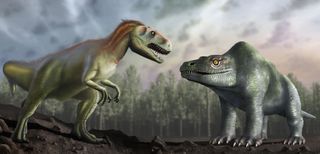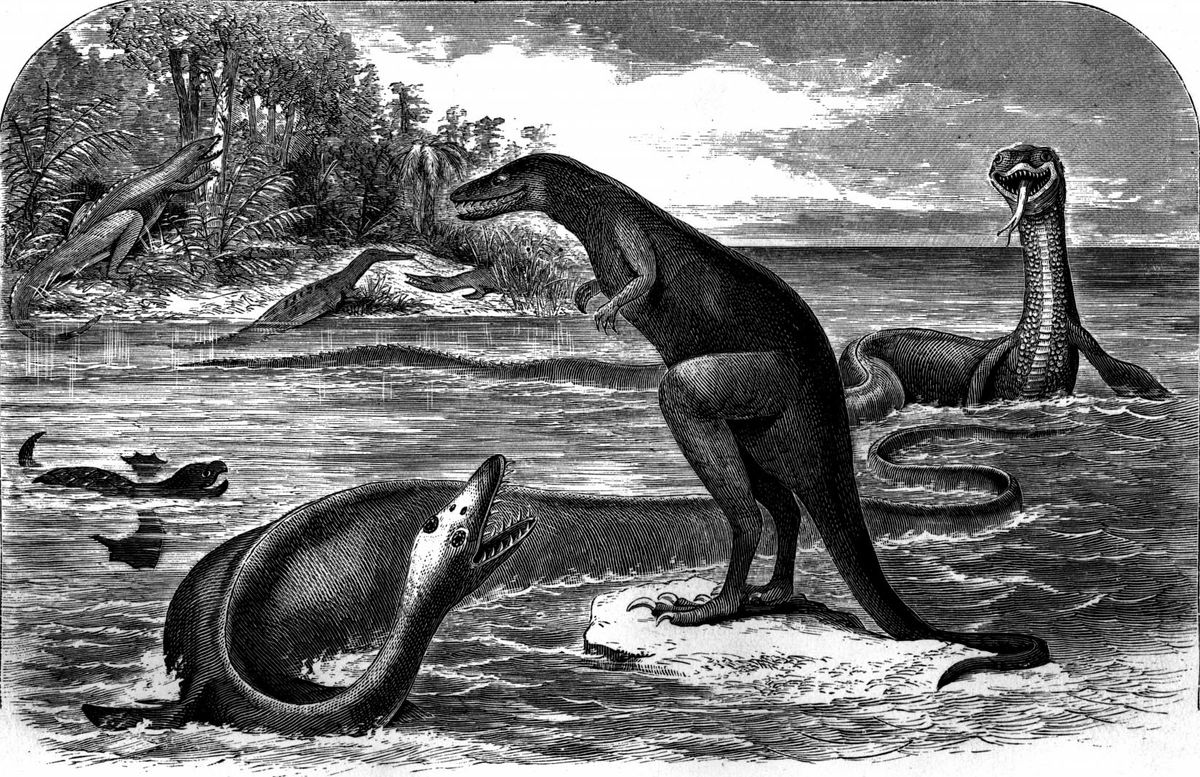Scientists and artists have been reconstructing the appearance of dinosaurs and other ancient creatures for centuries. But they’ve often gotten it wrong.
Whether they were hampered by a lack of bones, limited by the knowledge and research techniques of their day, or simply made a blunder, there have been some striking misinterpretations of the fossil record.
From a sea monster’s head being on the wrong end of its body to thinking pterosaurs were flying marsupials, here are 10 creatures from the dinosaur age that looked way different than scientists initially thought.
Keep in mind that while paleontology has come a long way since the discovery of the first dinosaur in 1824, scientists still have a lot to learn about these ancient animals, and interpretations of what they looked like are always subject to change.
Iguanodon
Husband and wife pair Mary Ann and Gideon Algernon Mantell discovered the first Iguanodon fossils in 1822. Gideon, an amateur paleontologist, tried to determine what this ancient herbivore looked like when it was alive during the Cretaceous period (145 million to 66 million years ago). He settled on an appearance that was similar to a living iguana, albeit giant, because their teeth were similar — Iguanodon means “Iguana tooth.”
The first relatively complete Iguanodon skeletons emerged towards the end of the 19th century and suggested a bipedal form. Today, researchers know that Iguanodon mostly walked on all fours, but could move bipedally while using its hands for grasping.
The fossils also had two spikes, which were initially depicted as a horn — perhaps because living rhinoceros iguanas (Cyclura cornuta) have a small horn — that later turned out to be thumbs, according to the Natural History Museum in London.
Iguanodon became one of the first known dinosaurs in 1842 when English paleontologist Richard Owen coined the clade name “Dinosauria,” which is Greek for “terrible lizard,” according to the book “Dinosaurs Rediscovered” (Thames & Hudson, 2019).
Related: Dinosaur puke and poop help reveal how they took over the world
Megalosaurus

Megalosaurus was a large carnivore that lived during the Jurassic period (201 million to 145 million years ago). In 1824, the species became the first dinosaur to be scientifically described and named. Victorian scientists initially believed that Megalosaurus was a squat, four-legged creature, with early illustrations and sculptures depicting a giant reptilian creature with the head of a crocodile and a rhino-like physique. Through the discovery of additional fossils, researchers learned that Megalosaurus had shorter forelimbs and walked on two legs, according to the University of Oxford’s Museum of Natural History.
Modern illustrations of Megalosaurus depict a predator that was built more like a Tyrannosaurus rex than a rhino. The dinosaur was around 30 feet (9 meters) long and weighed 1.5 tons (1.4 metric tons).
Velociraptor
The Velociraptors depicted in the “Jurassic Park” film franchise were never an accurate representation of what scientists thought these Cretaceous predators looked like. Those silver-screen dinosaurs were based on the much larger — but less cool-sounding — Deinonychus. In reality, Velociraptors were only about the size of a domestic turkey (Meleagris gallopavo domesticus) and probably used their claws for pinning and grasping rather than slashing, like in the movies. However, even the scientific illustrations of Velociraptor have changed a lot over the years.
In 2007, researchers confirmed that Velociraptors had feathers. The presence of feathers gave Velociraptors a whole new look that was far more bird-like than how they — or Deinonychus — were previously depicted.
Tyrannosaurus rex
T. rex was one of the largest carnivorous dinosaurs and easily the most iconic. The “tyrant lizard king” lived at the end of the Cretaceous, and while its tiny arms have never been in doubt, interpretations of some of its other features have shifted significantly.
One major difference between early and modern reconstructions of T. rex is its stance. Initially, T. rex was depicted in an upright stance, similar to that of a kangaroo. Scientists now know that T. rex‘s body was basically horizontal above the legs, with its head and tail balancing each end.
Paleontologists have also come to the conclusion that T. rex would have had feathers when it was young to stay warm. There’s still some debate about whether they kept these feathers as they grew up. An adult T. rex wouldn’t have needed feathers because large warm-blooded animals generate enough body heat to live without feathers or fur, according to the American Museum of Natural History.
Researchers are still assessing the size of T. rex, but it could have been much larger than originally thought. The heaviest T. rex on record, discovered in 1991, weighed 19,555 pounds (8,870 kg) when it was alive. However, a 2024 study published in the journal Ecology and Evolution estimated that the largest T. rex could have weighed 33,000 pounds (15,000 kilograms), almost doubling its known size — though researchers haven’t found a T. rex that large yet.
Related: T. rex relative with giant, protruding eyebrows discovered in Kyrgyzstan
Pterosaurs
Pterosaurs were a group of winged reptiles that dominated the skies during the age of dinosaurs. Italian scientist Cosimo Collini identified the first pterosaur fossils in 1784 — they belonged to the Pterodactylus genus, which is where we get the informal name “Pterodactyl.” Collini thought that the fossils belonged to a marine creature, misinterpreting its wings as paddles. He wasn’t the only one to get this creature wrong. In 1843, biologist Edward Newman suggested that they were flying marsupials, according to paleontologist David Hone’s Archosaur Musings blog.
French naturalist Georges Cuvier first proposed that Pterosaurs could fly in 1801. Scientists later discovered that some pterosaurs, such as Sordes pilosus and Jeholopterus ninchengensis, had hair-like filaments that would have given them furry coats. Pterosaurs could also have been very colorful, like modern birds, although this is still debated.
Spinosaurus
Spinosaurus has puzzled scientists since its discovery in 1915. At around 50 feet (15 m) long, Spinosaurus is the longest-known carnivorous dinosaur in the fossil record and must have been a mighty predator in the Cretaceous ecosystem. The species was also equipped with a variety of unique features, including a large sail on its back.
Paleontologists initially believed that Spinosaurus only lived on land and therefore had long hind legs like T. rex. However, that early interpretation proved to be incorrect. Researchers now think that Spinosaurus lived a semi-aquatic lifestyle with short legs and a wide tail it could use as a paddle, according to the Natural History Museum. While the modern interpretation of Spinosaurus is that it was a swimmer, scientists are still debating how often it would have swam and the extent to which this dinosaur was specialized for hunting in water.
Mosasaurus
Mosasaurus was an apex predator during the Cretaceous. While dinosaurs dominated the land, this marine reptile ruled the seas. Early depictions showed them slithering through the water like a lizard or snake, and while their ancestors may have started out swimming that way, it is now understood that they evolved streamlined bodies and crescent-shaped tail flukes to propel them through the water. In other words, their swimming would have been similar to sharks.
A 19th-century mosasaur statue in Crystal Palace Park in London is incomplete but demonstrates how paleontologists initially thought they had wider profiles, with nostrils on the tops of their heads rather than on the sides, according to the Friends of Crystal Palace Dinosaurs website.
Related: Dinosaur-age sea monster with ‘face full of huge, dagger-shaped teeth’ discovered in Moroccan mine
Scleromochlus
Scleromochlus taylori lived in the Triassic period (252 million to 201 million years ago). Scientists originally interpreted S. taylori fossils to be from those of a dinosaur similar to T. rex, albeit considerably smaller with a length of around 7 inches (20 centimeters). However, researchers now believe that S. taylori was more closely related to the flying reptile group of pterosaurs.
After its discovery in 1907, paleontologists debated where S. taylori fit on the tree of life for decades, with disagreement as to whether it was affiliated with dinosaurs, pterosaurs or another reptile offshoot. While S. taylori didn’t have wings, modern illustrations depict this species as much more bird-like than past reconstructions suggested.
Elasmosaurus
Elasmosaurus platyurus was a plesiosaur that prowled the oceans of North America towards the end of the Cretaceous period. Paleontologist Edward Drinker Cope made a big error when reconstructing E. platyurus fossils for the first time in 1868. He assumed that the marine reptile’s head went on the short end of its body rather than the long end, misinterpreting the creature’s long neck as its tail, according to a 2002 study published in the journal Proceedings of the Academy of Natural Sciences of Philadelphia.
Cope’s mistake, immortalized in his 1869 life illustration of E. platyurus, haunted the paleontologist for the rest of his career. Another paleontologist from the same period, Othniel Marsh, pointed out the error, which contributed to a bitter feud between the two men that later became known as the “bone wars,” according to The Houston Museum of Natural Science.
Cetiosaurus
Cetiosaurus was a giant Jurassic sauropod that stood around 60 feet (18 m) long. However, when researchers first discovered it in 1841, nobody knew what a sauropod was, and Cetiosaurus was completely misidentified. The first interpretation of Cetiosaurus fossils was that they belonged to a massive crocodile-like predator that lived in the sea, according to Smithsonian Magazine.
Later interpretations placed Cetiosaurus as a semi-aquatic dinosaur that used water to help support its massive size. Out of water, the creature was depicted as dragging its tail along the ground as if it was too heavy to be held up.
However, paleontologists later discovered that Cetiosaurus, and sauropods like it, would have been unsuitable for a semi-aquatic lifestyle because they had air-filled bones and small feet, according to the Natural History Museum. Today, researchers believe that sauropods lived on land with their tails held in the air.
Related: Enormous dinosaur dubbed Shiva ‘The Destroyer’ is one of the biggest ever discovered


